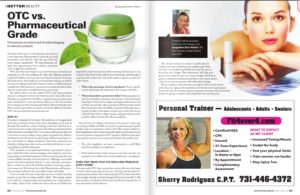What to look for when shopping for skincare products
The lowdown on what to look for when shopping for skincare products.
By Jacqueline Starr-Hubert
No matter where you are in the aging process, skincare is very important. Having youth on your side can make any product seem effective. After the age of 40, one’s needs change considerably. We stop producing collagen, thus experiencing a loss in volume, and gravity starts its ugly dance downward.
With all of the media hype, it’s no secret why most consumers are confused as to the best products for their skin. Skincare generates roughly $43 billion in revenue each year, with that number increasing. The good news is that people are concerned about taking care of their skin and are willing to spend the money to achieve a healthy and more youthful look. The bad news is consumers are uneducated about their skin care needs and are virtually throwing money away.
The debate about over-the-counter (OTC) and pharmaceutical skincare is a frequent conversation between patient and professional. Whether you spend $10 or $1,000, it’s important you are getting real value and benefit for your investment. Skincare is the least invasive way to change your skin. Starting early will pay off later down the road. But, in order to get results, one needs to know the difference between OTC skin care and pharmaceutical skin care.
Skin 101
Our skin is comprised of two layers. The epidermis is the upper layer of the skin consisting of four-to-five layers depending on the area of the body. The epidermis consists of dying or dead skin cells that act as a barrier from the outside environment. The dermis is the deeper layer of the skin that is considered “live,” as it consists of living skin cells, and is the home of nerve endings, sweat glands, oil glands, hair follicles, and blood vessels. The dermis is a thick layer of fibrous and elastic tissue––also known as collagen and elastin. These two components are vital when talking about skin care because they hold the key to creating healthier, youthful looking skin.
OTC products can be purchased without a prescription and are easy to find. Most have pretty packaging, color, fragrance, and most importantly, are relatively inexpensive. Pharmaceutical grade skin care is only available through a licensed physician. Although most would assume that pharmaceutical skincare is more expensive, sometimes that is not the case. Don’t be fooled by products containing a physician’s name on it. The bottom line is this: Manufacturers will not produce an active product for fear of possible misuse and liability.
If you are under 40 years of age and acne-free, virtually anything you put on your face can help provide a “glow.” But, change cannot occur without a strong enough active ingredient and a high penetration ability. Don’t let the smoke and mirrors throw you. Before you impulsively make that purchase while watching infomercials or stop in front of the kiosk in the mall, do your homework, seek the help of a professional to determine your skin’s needs, or please consider two major factors.
- What is the percentage of active ingredients? Active ingredients are what create the rejuvenation and change in the skin.
- What is the product’s penetration ability? Medical grade products have the ability to penetrate the top layer of skin, hitting the lower layer of skin where collagen and pigmentation lay as well as where our new skin cells are produced. Pharmaceutical-grade skin care products have the ability to penetrate the epidermis, or top layer of skin, to the dermis or lower layer of skin. The dermis is the skin layer where collagen, elastin, and pigmentation reside, as well as where our new skin cells are produced.
Since the loss of collagen and elastin in the dermis is what ages us, causing wrinkles and folds, we need to use pharmaceutical-grade products that can penetrate to dermis level. That requires highly refined ingredients, and is that reason why medical-grade skincare can be more expensive compared to OTC products. Medical-grade skincare products may seem more expensive but they offer greater value.
- The active ingredients are more concentrated, so you’ll likely need fewer products per application.
- You’ll achieve better results and gain more from any skin care treatments if you follow the recommended home care regimen.
Does that mean that OTC skin care products don’t work?
Not necessarily. OTC skin care products are less effective, take longer to work, and are more expensive to use in the long run than pharmaceutical-grade products. Generally speaking, OTC products just don’t have enough strength to reverse damage. If you are in your 20s to 30s, those products are adequate. Enter into your 40s by raising the bar on your expectation of your skincare.
The smartest option is to seek out a professional to evaluate your skin and discuss your esthetic goals. Start out with a few products and build from that. Be open to discussing your budget. That information will help your professional make the best use of your budget. You’ll have greater confidence knowing your products were chosen specifically for your skin by someone with skill and knowledge.
Being compliant with your skin care regime will save you money in the long run. Aging is the inevitable. Invest wisely now or pay big later. Don’t wait until the situation requires expensive treatment and inconvenient downtime. Just be consistent. Remember have fun and stay savvy.
Related posts
Leave a Comment
You must be logged in to post a comment.







